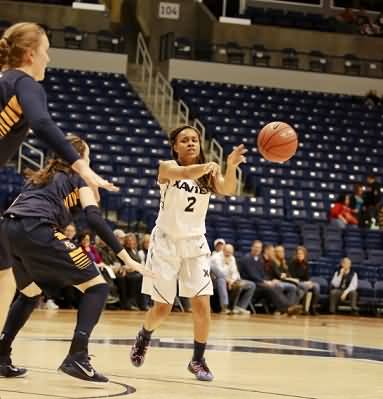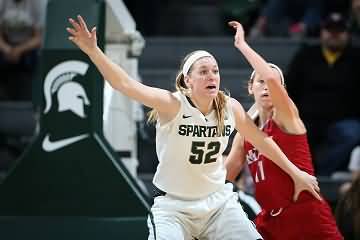Tips for Better Passing
By Dr. James Gels, From the Coach’s Clipboard Basketball Playbook"Helping coaches coach better..."
Poor passing will destroy your offense, resulting in possessions with no shots and breakaway lay-ups for your opponent. These passing tips should help.
You can do specific passing drills. I like the idea of treating every drill as a passing drill. Most shooting drills involve making a pass to the shooter, and the same with transition drills and other offense-defense drills. So in doing these drills, stress the importance of good passing - every drill, every day.
Make a bad pass have consequences, perhaps push-ups or laps for that player. There are two components of every pass - the pass and the reception. The bad pass might a passing error, a receiving error, or both.
Breaking Down Passing Fundamentals
1. What is a good pass?
Good passes are "on-time and on-target". A good pass is one that is caught in a spot on the court where something good can happen. A pass might be "on target" but if it's too hard for the receiver to catch, it's not a good pass. Or if the pass is caught by a receiver surrounded by defenders, it's not a good pass. Another example is a pass to a back-cutter. The pass should be delivered early in the back-cut and not later when the cutter is already near the basket.2. "On-target"
A good pass needs to be delivered precisely in the right place, "on target", where the receiver can easily catch it and execute. If the pass is a little too high, too low, or a little off line, it might be caught, but the brief second required for the receiver to gather the ball allows the defender to adjust, and now the open shot is not there. Teach your players to pass the ball precisely where the receiver can use it to score - "on-target".Most often the target is the "shooting pocket" where one would place the ball in triple-threat position. However, when passing into the post, we want the target up higher near the post player's face. He/she can usually catch this pass and "chin the ball" with elbows up and out, or go right up with the shot.
Post players have difficulty catching and using passes below the waist. We used to teach the bounce pass for feeding the post, and it's still a good pass if it's not below the post player's waist. But you now see more teams making the air pass to the post player's upper body or head area.

3. "See the defense"
Passers have to develop their court vision, see the defense, and avoid passing into traffic where defenders are waiting. Players should "pass away from the defense". How do you improve court vision? Teach players on the perimeter to get in triple-threat position, and they will see things better.4. Make the sure pass
Players should make the sure, easy pass, not a risky pass that might not be caught, or might be deflected or intercepted.5. Keep it simple
Players should keep things simple... make the easiest pass that will get the job done, usually a two-handed, sure pass. Many players throw one-handed passes that are often not caught, either because the pass is errant, or because the ball has a sideways spin making it difficult to catch.Having said that, one-handed passes are good to use for a curl-bounce pass into the low-post, or when attacking on the fast-break. The behind the back pass is fun and sometimes is the correct pass to make, but most often the best pass is the simple two-handed pass.
6. Use pass-fakes
Teach players how to make a good pass-fake. Bob Knight has said that the pass fake and the shot fake are the two most overlooked, under taught fundamentals. A good passer can get the defense to shift by faking a pass in another direction. This often opens up the intended passing lane. Teaching pass-fakes helps players not to "telegraph" passes. Good passers can often "look" a defender off to open a passing lane.7. Don't hurry - patience!
Bad-passing often comes from players being in a hurry. Players must learn to be patient. We want our players to sprint up the court for easy fast-break lay-ups. But they must learn to recognize when the shot off the break is not there, to bring the ball back out on top and run the offense.8. Keep grounded - avoid the jump-pass
How often do you see a player attacking with the dribble and ending the dribble with a leap into the air, and making a jump-pass while in mid-air? Kids see this on TV and think it's a sign of athleticism to make the jump-pass.Sometimes a jump-pass can be the correct pass, but often it results in a turnover. Teach passers to stay grounded and make good, controlled two-handed passes. We don't want our players making decisions in mid-air. The jump-pass is often the result of a player being in a hurry.
9. Use the dribble to create a passing lane
A player on the wing can sometimes open up a passing lane into the low-post by making one dribble either left or right before making the pass inside. Or make a dribble-drive, draw in the helpside defense, and then make a kick-out pass to an open perimeter player.Try the "Bennett drill" to improve your half-court passing.
Catching - Receiving
If you don't catch the pass, it's usually a turnover.1. Catch the ball with two-hands
Often when players try to catch the ball with one-hand, they don't catch it at all. Sometimes the one-handed catch is the best option, but whenever possible, catch the ball with two-hands.2. Use a hand target
Teach receivers to use a hand signal, holding a hand up as a target for the pass. This helps avoid the mis-communication problem of the passer passing the ball just as the intended receiver starts a cut in another direction. When the cutter starts the cut, he/she drops target hand down, and puts it back up when ready to receive the pass.
3. Get to the ball
Receivers should move toward the ball, with hands ready. A post player also has to get to the pass, even if it means giving up the position that he/she has worked so hard to get. All that work is wasted if the pass goes out-of-bounds. It's like a first baseman in baseball coming off the bag to catch an errant throw.4. Catch the ball in triple-threat position
Perimeter players should get in the habit of catching the ball and getting right into triple-threat position, rather than immediately starting the dribble. In triple-threat position, the player can gather himself, see the court, look into the post, see cutters and see the defense. Triple-threat position helps reign-in a player that tends to rush and hurry things.5. "Ball in the air, feet in the air"
We like to have receivers catch the ball with a jump-stop and establish a pivot foot(show video).
Related pages:
- The Art of Passing
- Half-Court Passing Drills
- Full-Court 2-Line Passing Drills
- Full-Court Weave Passing Drills
- More Full-Court Passing Drills